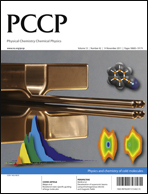Infrared dynamic polarizability of HD+ rovibrational states
Abstract
A calculation of dynamic polarizabilities of rovibrational states with vibrational quantum number v = 0–7 and rotational quantum number J = 0,1 in the 1sσg ground-state potential of HD+ is presented. Polarizability contributions by transitions involving other 1sσg rovibrational states are explicitly calculated, whereas contributions by electronic transitions are treated quasi-statically and partially derived from existing data [R. E. Moss and L. Valenzano, Mol. Phys., 2002, 100, 1527]. Our model is valid for wavelengths >4 μm and is used to assess level shifts due to the blackbody radiation (BBR) electric field encountered in experimental high-resolution

- This article is part of the themed collection: Physics and chemistry of cold molecules

 Please wait while we load your content...
Please wait while we load your content...